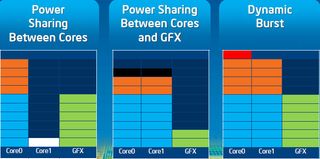Intel Silvermont Architecture: Does This Atom Change It All?
Power Management: The Key To Any Successful Mobile Architecture
To maximize the clock rate of its 32 nm Saltwell-based core, Intel employed a feature that opportunistically exposed additional P-states based on available thermal headroom. Silvermont’s implementation of this is apparently more similar to Turbo Boost in that the burst frequency is managed in hardware according to thermal, electrical, and power measurements. More important than the extra speed you get from this burst mode, though, is how it handles the ride back down.
Presently, there are mobile devices that will run at full-speed until they’re thermally overwhelmed, at which point they throttle back dramatically to recover. It’s jarring enough to affect the user experience. Intel is saying that Silvermont will handle those situations more elegantly, stepping back clock rate naturally before a thermal event is triggered.

The SoC’s power budget can be shared between the cores and other IP on the die, including third-party IP. Graphics is probably the most notable. The illustration below describes this behavior pretty clearly: cores can share power, cores can borrow budget from the graphics (which spins down), and cores can burst up dynamically, even with graphics active, if the thermal situation is favorable enough. Intel says the concepts come from Turbo Boost, but the algorithms and implementation mechanisms are different.

Coming back the other direction, Intel enables a lot of familiar core power state functionality, with the addition that cores can drop into C6 independently, whereas they couldn’t before. And because Silvermont is module-based, Intel introduced sub-states allowing software policy-based control of the L2 cache’s contents, too. Building on the S0ix connected standby system states introduced back in 2010 with the Moorsetown platform, Silvermont can now retain the state of the core through SoC standby mode transitions. This means you can resume from those modes faster, though Intel wasn’t clear on how much faster.
Stay on the Cutting Edge
Join the experts who read Tom's Hardware for the inside track on enthusiast PC tech news — and have for over 25 years. We'll send breaking news and in-depth reviews of CPUs, GPUs, AI, maker hardware and more straight to your inbox.
Current page: Power Management: The Key To Any Successful Mobile Architecture
Prev Page The Silvermont Architecture Next Page Putting It All Together-
hero1 Nice article as always C.A. I would really like to see this chip on a smartphone. If the performance and power utilisation is as good as it looks then Qualcomm will really feel the heat. Intel has the money and R&D to pull off a big move and compete. Time will tell.Reply -
SchizoFrog I wonder if there are any plans to release Windows Phone 8 smartphones with these SoCs over the next 12-24 months? That would really solidify the eco-system for both Intel and Microsoft in one fell swoop.Reply -
hannibal Much needed upgrades in here. Hopefully they allso deliver what they promise in these slides. Any devices out in this year or do we have to wait untill 2014 we see something based on these. But very promising indeed! A windows pro tablet based on these at desent price would be first candidate to start good move to Windows based tablets. Then there would be three good alternatives in tablets.Reply
-
de5_Roy bulldozer!Reply
.. is the first thing came to my mind when i started reading about the cores. but it's not exactly like bd, it's different. still.. it made me chuckle. amd deserves the credit.
i wonder if future intel cpus ($330+ core i7) will have the same core system instead of htt.... :whistle: :ange: :lol:
edit2: rodney dangerfield FTW! \o/ -
tipoo de5_Roybulldozer!.. is the first thing came to my mind when i started reading about the cores. but it's not exactly like bd, it's different. still.. it made me chuckle. amd deserves the credit.Reply
Well, it's just the cache that's shared in this one, no actual execution resources. -
esrever Finally intel is getting serious. Ditching hyperthreading is the best thing they could have possibly done. Now with OoO and real cores these atoms are looks pretty powerful. They will probably beat Kabini no problem with higher clocks with slightly less IPC. The 22nm trigate will drop power consumption especially without the shitty hyperthreading in the way.Reply -
de5_Roy Reply
i noticed the lack of information on the integrated graphics part. having a powerful cpu isn't enough for atom. the gpu part has always been the weakest point for intel. kabini otoh, will have gcn-based, hsa enabled, low power igpu.10768040 said:Finally intel is getting serious. Ditching hyperthreading is the best thing they could have possibly done. Now with OoO and real cores these atoms are looks pretty powerful. They will probably beat Kabini no problem with higher clocks with slightly less IPC. The 22nm trigate will drop power consumption especially without the shitty hyperthreading in the way.
-
4745454b So they still have an off die memory controller. I would have thought they would have moved that on die by now.Reply
Any more info on this "system agent" and IDI? I'm also surprised the cores can't talk directly to each other. If you want to use many small cores to tackle a problem together that's fine. But give them the ability to do it quickly.
It seems Intel is getting the ball rolling on their smaller chips. I just hope that when they finally do they ditch the Atom name. Bad chips, get a new name for those that aren't. -
esrever de5_Royi noticed the lack of information on the integrated graphics part. having a powerful cpu isn't enough for atom. the gpu part has always been the weakest point for intel. kabini otoh, will have gcn-based, hsa enabled, low power igpu.Too true. Not a single mention of it probably means it won't be anything to brag about. Intel isn't really the type of company that likes to hide breakthroughs anywhere. Im expecting them to finally be able to do 1080p tablets and thats about it.Reply -
jerryblack No, it won't, regardless of what Intel's press release says. If I've learned anything in the past few years, is never take what Intel says in the PR at face value, because it never turns out true.Reply
Silvermont may arrive a few months before the 20nm process for ARM chips is ready, but will that be enough, considering Intel's chips cost 2-3x more than the ARM equivalent? Probably not.
Most Popular


